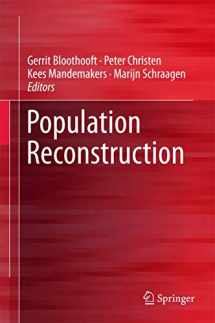
Population Reconstruction
ISBN-13:
9783319198835
ISBN-10:
3319198831
Edition:
1st ed. 2015
Author:
Gerrit Bloothooft, Peter Christen, Kees Mandemakers, Marijn Schraagen
Publication date:
2015
Publisher:
Springer
Format:
Hardcover
312 pages
Category:
Computer Science
FREE US shipping
Book details
ISBN-13:
9783319198835
ISBN-10:
3319198831
Edition:
1st ed. 2015
Author:
Gerrit Bloothooft, Peter Christen, Kees Mandemakers, Marijn Schraagen
Publication date:
2015
Publisher:
Springer
Format:
Hardcover
312 pages
Category:
Computer Science
Summary
Population Reconstruction (ISBN-13: 9783319198835 and ISBN-10: 3319198831), written by authors
Gerrit Bloothooft, Peter Christen, Kees Mandemakers, Marijn Schraagen, was published by Springer in 2015.
With an overall rating of 4.4 stars, it's a notable title among other
Computer Science
books. You can easily purchase or rent Population Reconstruction (Hardcover) from BooksRun,
along with many other new and used
Computer Science
books
and textbooks.
And, if you're looking to sell your copy, our current buyback offer is $0.3.
Description
This book addresses the problems that are encountered, and solutions that have been proposed, when we aim to identify people and to reconstruct populations under conditions where information is scarce, ambiguous, fuzzy and sometimes erroneous. The process from handwritten registers to a reconstructed digitized population consists of three major phases, reflected in the three main sections of this book. The first phase involves transcribing and digitizing the data while structuring the information in a meaningful and efficient way. In the second phase, records that refer to the same person or group of persons are identified by a process of linkage. In the third and final phase, the information on an individual is combined into a reconstruction of their life course.The studies and examples in this book originate from a range of countries, each with its own cultural and administrative characteristics, and from medieval charters through historical censuses and vital registration, to the modern issue of privacy preservation. Despite the diverse places and times addressed, they all share the study of fundamental issues when it comes to model reasoning for population reconstruction and the possibilities and limitations of information technology to support this process.It is thus not a single discipline that is involved in such an endeavor. Historians, social scientists, and linguists represent the humanities through their knowledge of the complexity of the past, the limitations of sources, and the possible interpretations of information. The availability of big data from digitized archives and the need for complex analyses to identify individuals calls for the involvement of computer scientists. With contributions from all these fields, often in direct cooperation, this book is at the heart of the digital humanities, and will hopefully offer a source of inspiration for future investigations.


We would LOVE it if you could help us and other readers by reviewing the book
Book review

Congratulations! We have received your book review.
{user}
{createdAt}
by {truncated_author}


